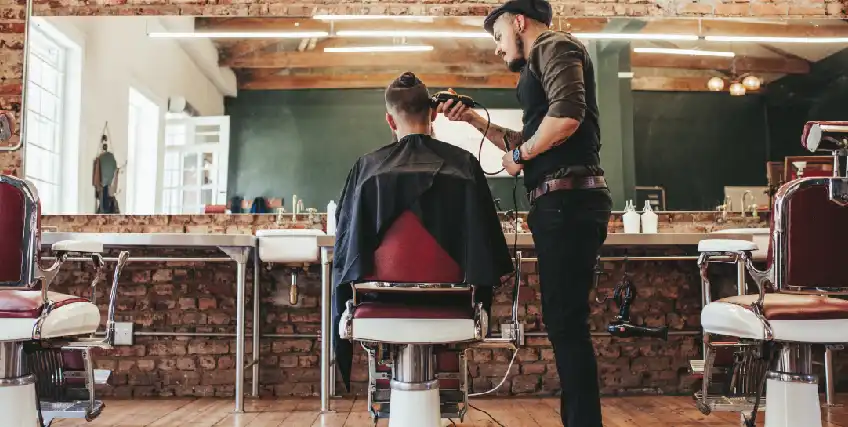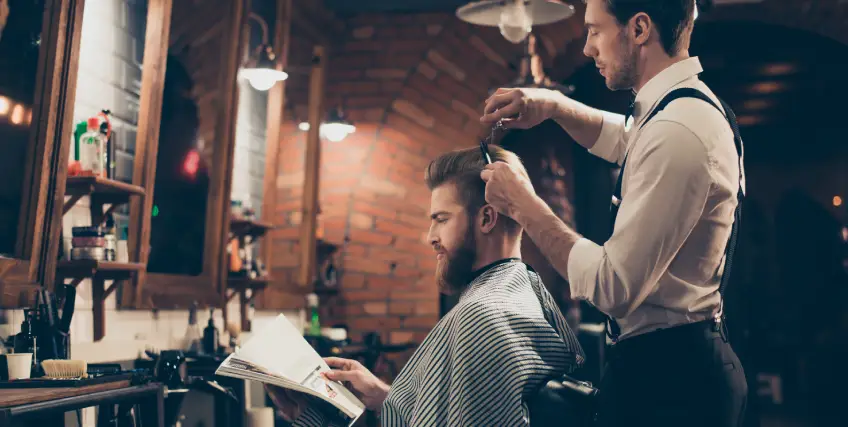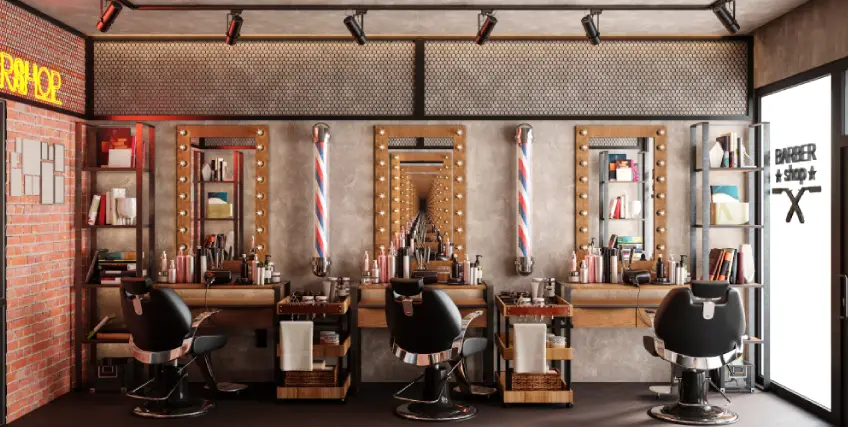Barbershop vs Salon: How to Choose the Right Business for You
March 17, 2025 | Last Updated on: March 17, 2025

Starting a grooming business can be a smart business move today. Due to the significant increase in disposable income, social media influence, and awareness of wellness practices, there is a growing emphasis on personal grooming and self-care. People are seeking professional care to enhance their appearance and overall wellbeing. This has created space for barbershops and salons to grow at a steady, if not notable, rate. According to IBIS Industry Research Report, barbershop and salon revenue grew at a CAGR of 1.7% to an estimated $5.8 billion in 2024.
However, if you are planning to open a grooming business, how do you decide which one you want to go with – barbershops or salons - and which one is more profitable?
The debate around barbershops and salons is not a new one. In the past, it had been easier to differentiate between the two businesses since the line differentiating them was clear - gender and hair length often dictated whether someone visited a barbershop or a salon. However, it’s not the same scenario today. Nowadays, personal grooming preferences and style choices play a much bigger role. Whether you’re working on your barbershop business plan or deciding where to go for a more full-service set up, understanding how these two businesses differ can help you make the right choice.
In this article, we will explain all the important aspects of both the businesses - from target customers to financial planning. Whether you are just exploring the idea of opening a salon or barbershop or already drafting a salon and barbershop business plan, this will help.
Understanding the Barbershop Business Model
Since the beginning, barbershops had always focused on men’s grooming and till today, the core of the business has not changed. Grooming services offered at these establishments include haircuts, shaves, and beard trims. Although many barbershops tend to stick to classic hairstyles, there are some that offer modern cuts too. The vibe remains casual in comparison to salon and customers usually want quick service without fancy extras.
Some barbershops become social hubs where people catch up on local news. It becomes an unofficial community centre.
While preparing your barbershop business plan, you’ll need to put focus on this unique culture. Your plan should also show how your services fit the local demand. If your area has a high male population, a barbershop could be a good fit.
Understanding the Salon Business Model
Simply put, salons just provide a wider range of services than barbershops. These include haircuts, haircare, colouring, styling, and treatments for both men and women. Many salons also offer nails, waxing, and skincare.
Another major distinction between salons and barbershops is that a salon generally focuses on creating and providing a premium experience. It is evident in the kind of ambience, products, styles and services that you will find in most salons.
If you’re working on your salon business plan, you need to cover these broader services. The plan should also show how your salon will stand out in a competitive beauty market. Remember that the business plan of a barbershop looks very different from a salon plan. Salons need more staff with different specialties, which adds to costs.
Comparing Barbershop and Salon Target Audiences
The target market for a barbershop is usually men, looking for regular trims. Salons, however, target a broader group. Women, men, and families all visit salons for different services.
If your community has many families or professionals looking for a full-service experience, a salon could work well. But if your area has a strong demand for fast, affordable cuts, a barbershop might be a better choice.
Your barbershop business plan should explain how your target market shapes your pricing, marketing, and service offerings.
Initial Costs: Barbershop vs. Salon
Barbershops generally cost less to open than salons, thanks to their smaller service range and simpler equipment needs. As a result, it is a great opportunity for aspiring entrepreneurs who want their own barbershops, to make it a reality. Based on location, size, and service offerings, you might need to spend between $50,000 and $150,000 to open a barbershop.
The cost goes up significantly when it comes to salons. With their more extensive menus, salon require more space, equipment, and product inventory. Hence business owners looking to open a salon should gear up to spend from $40,000 to $500,000, especially for full-service salons in high-traffic locations.
| Cost Category | Barbershop | Salon |
|---|---|---|
| Leasehold Improvements | $10,000-$50,000 | $25,000-$100,000 |
| Equipment | $10,000-$25,000 | $20,000-$50,000 |
| Initial Inventory | $5,000-$10,00 | $15,000-$30,000 |
| Licensing | $500-$2,000 | $1,000-$5,000 |
If you’re writing your barbershop business plan, do not forget to include real cost data as it helps in building credibility when it comes to secure funding.
Staffing and Licensing Needs
Barbershops hire licensed barbers trained in traditional cuts, fades, and shaves. Many barbers also build personal relationships with clients over time.
Salons need a more diverse team. You’ll need hairstylists, colourists, nail techs, and aestheticians or a beautician. Each position requires different licenses, depending on state laws.
Your business plan of barbershop or salon plan must outline how you’ll recruit and train staff. Adding a section about licensing shows you understand legal requirements that are needed to be a part of barbershop industry, which adds credibility.
Service Menus: Barbershop vs. Salon
Barbershops stick to core services: haircuts, shaves, and basic grooming. This limited menu keeps operations simple. It also helps you control inventory and staff training.
Salons, however, offer everything from hair colour and styling to waxing and facials. This broader service range appeals to more customers, but it also means higher overhead.
If you’re creating a salon and barbershop business plan, be clear about your service offerings. Listing every service, product, and pricing tier helps build a realistic financial forecast.
The service list in your barbershop business plan should also reflect customer preferences in your area.
Community Fit and Local Demand
Understanding your neighbourhood is key when deciding between a barbershop or salon. Is the community mostly families, professionals, or younger singles? Do they prefer traditional barbers or upscale salons?
If your area values quick, affordable grooming, a barbershop could be ideal. If clients want colour, styling, and pampering, a salon may be better.
Your barbershop business plan should show you’ve researched local trends. A clear understanding of community needs helps attract financing and builds long-term success.
Marketing Approaches: Barbershop vs. Salon
Barbershops often rely on word-of-mouth and local advertising. Community events, school partnerships, and referral discounts work well. Social media helps too, especially for showcasing trending cuts.
Salons benefit from digital marketing. Instagram, Facebook, and online booking platforms play a big role. Offering package deals and memberships can help attract repeat clients and new customers as well. It can also give you an added competitive advantage when you showcase your unique offerings in your promotions.
Whether you’re writing a starting a barbershop business plan or salon plan, your marketing section should match your target audience. Local marketing might suit a barbershop, while a salon may need influencer partnerships and digital campaigns.
Long-Term Profit Potential
Barbershops can build loyal customer bases, thanks to regular visits for trims and hot towel shaves. The steady demand helps maintain cash flow.
Salons may have higher ticket sizes per visit, especially when customers book multiple services. However, the broader service range also means higher costs.
When writing your barbershop business plan, show how your pricing, quality services, and marketing will drive profits. Whether you want to start a barbershop or run a salon, clear pricing strategy will help attract financing and showcase the viability of your own business.
Business Planning: Essential for Both Models
No matter which model you choose, a strong business plan is essential. Investors, landlords, and financing platforms want to see a clear roadmap.
Your business plan of a barber shop should cover location, services, target market, and financial projections. Salons need the same, but with more focus on service diversity and staff management.
A detailed barbershop business plan shows you’re serious. It helps secure financing and keeps you focused on long-term goals.
Financing Your Business: Barbershop or Salon
Securing the right financing is crucial for launching or expanding your barbershop or salon. Below are five popular financing options, each detailed to help you understand how they can fit into your barbershop business plan.
1. SBA 7(a) Loans
The SBA 7(a) loan program is a primary financial assistance tool for small businesses, offering loans up to $5 million. These loans can be utilized for various purposes, including working capital, equipment purchases, and real estate acquisition. For barbershops and salons, this means you can finance the purchase of new equipment, renovate your space, or even buy an existing business. The repayment terms can extend up to 25 years for real estate and up to 10 years for equipment and working capital, making it a flexible option to include in your barbershop business plan.
2. Equipment Financing
Investing in quality equipment is essential for the success of a barbershop or salon. Equipment financing allows you to acquire necessary tools and furniture without a significant upfront cost. Typically, the equipment itself serves as collateral, and repayment terms range from two to five years. This option helps maintain cash flow while ensuring your business is equipped to meet client expectations. Including equipment financing in your barbershop business plan demonstrates foresight in managing operational needs.
3. Business Lines of Credit
A business line of credit provides flexible access to funds, allowing you to draw and repay as needed, up to a predetermined limit. This financing option is particularly useful for managing cash flow fluctuations, purchasing inventory, or covering unexpected expenses. For barbershops and salons, a line of credit can help manage seasonal variations in client demand or fund short-term promotional activities. Incorporating a business line of credit into your barbershop business plan can showcase your strategy for maintaining financial stability.
4. Term Loans
Term loans involve borrowing a lump sum that is repaid over a fixed period with a set interest rate. These loans are suitable for significant investments such as remodelling your salon, expanding services, or purchasing high-cost equipment. The structured repayment schedule provides predictability in financial planning. Highlighting term loans in your barbershop business plan can illustrate your approach to funding substantial business enhancements.
5. SBA 504 Loans
The SBA 504 loan program offers up to $5 million in financing for purchasing real estate, renovating buildings, or acquiring long-term equipment. For beauty salons and barbershops looking to expand or upgrade their facilities, this loan can be an excellent fit. The SBA 504 loan program is designed to promote business growth and job creation, making it a valuable consideration for your barbershop business plan.
Incorporating these financing options into your barbershop business plan not only provides a roadmap for securing necessary funds but also demonstrates to potential investors and lenders that you have a comprehensive strategy for financial management. Each option has unique benefits and considerations, so aligning them with your business goals and financial situation is crucial.
Conclusion
Choosing between a barbershop and a salon isn’t just about personal preference. It’s about matching your skills, your community’s needs, and your financial goals.
A solid business plan helps you map out your path. Whether you’re drafting a starting a barbershop business plan or exploring a salon and barber shop business plan, thoughtful planning makes all the difference. And if you want to establish a successful barbershop, you will want to ensure that your planning is solid and has no room for errors.
Frequently Asked Question About Barbershops and Salons
How important is a barber shop business plan for financing?
A strong barbershop business plan is critical when applying for financing. Lenders and financing platforms want to see clear projections, realistic cost estimates, and a detailed marketing strategy. Even if you self-fund, a business plan keeps you focused and helps manage cash flow.
What equipment does a barber shop business plan typically list?
A complete barbershop business plan lists essential equipment like barber chairs, mirrors, clippers, sanitation stations, and payment systems. Inventory and equipment costs should reflect your service menu. Including accurate quotes shows financiers you understand real startup costs.
Can I use a salon and barber shop business plan template for both?
While you can start with a salon and barber shop business plan template, barbershops and salons have different service models, staffing, and equipment needs. Always customize your plan based on whether you plan to start a barbershop or a full-service salon.
What are typical revenue projections in a barber shop business plan?
A realistic barbershop business plan projects revenue based on average haircut prices, customer volume, and appointment frequency. A busy shop can see $100,000-$200,000 in annual revenue. Data-backed projections improve your financing chances.
How much does it cost to open a barbershop?
The cost to open a barbershop varies based on factors like location, size, and services offered. On average, startup costs range from $50,000 to $150,000.




